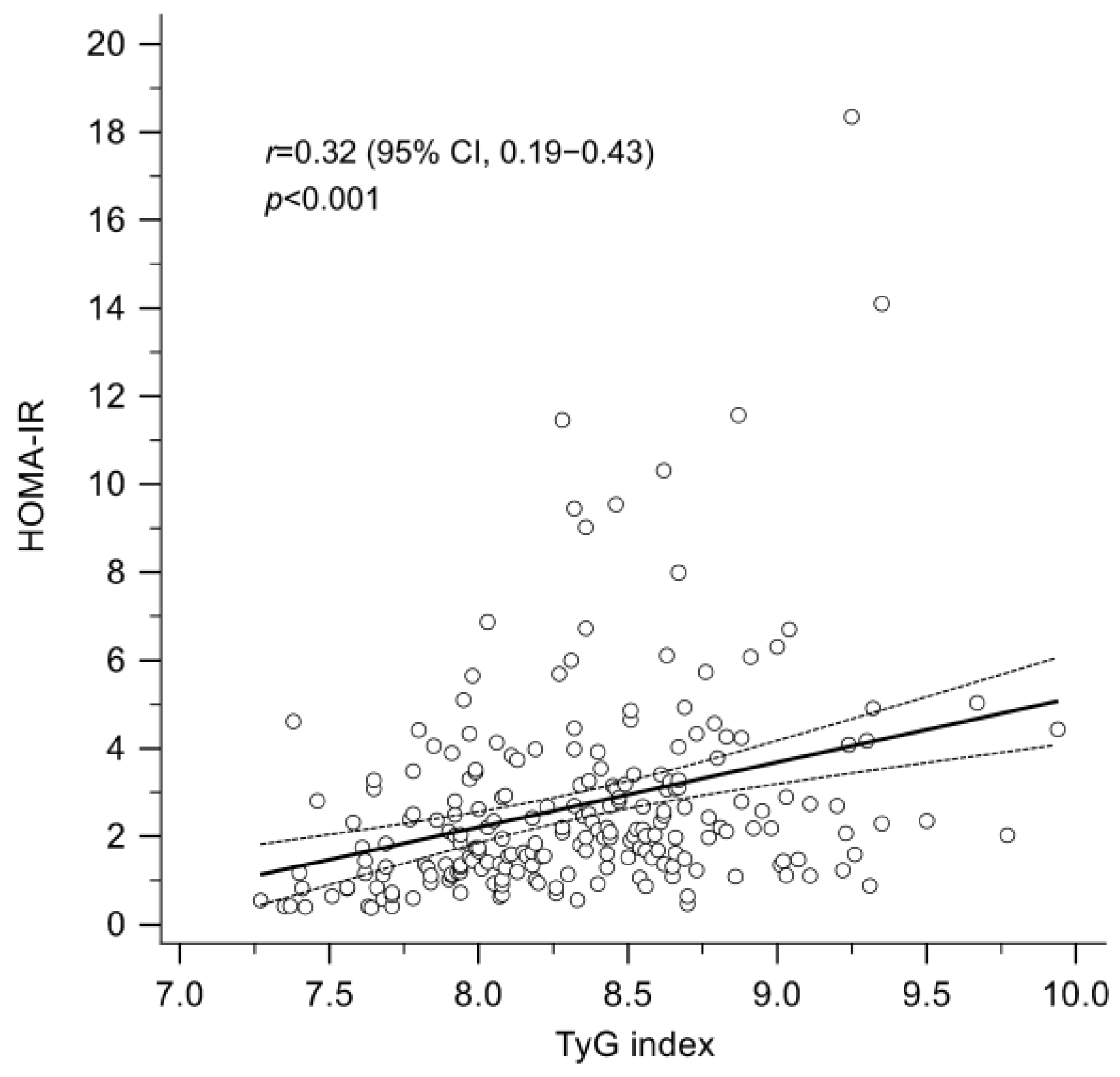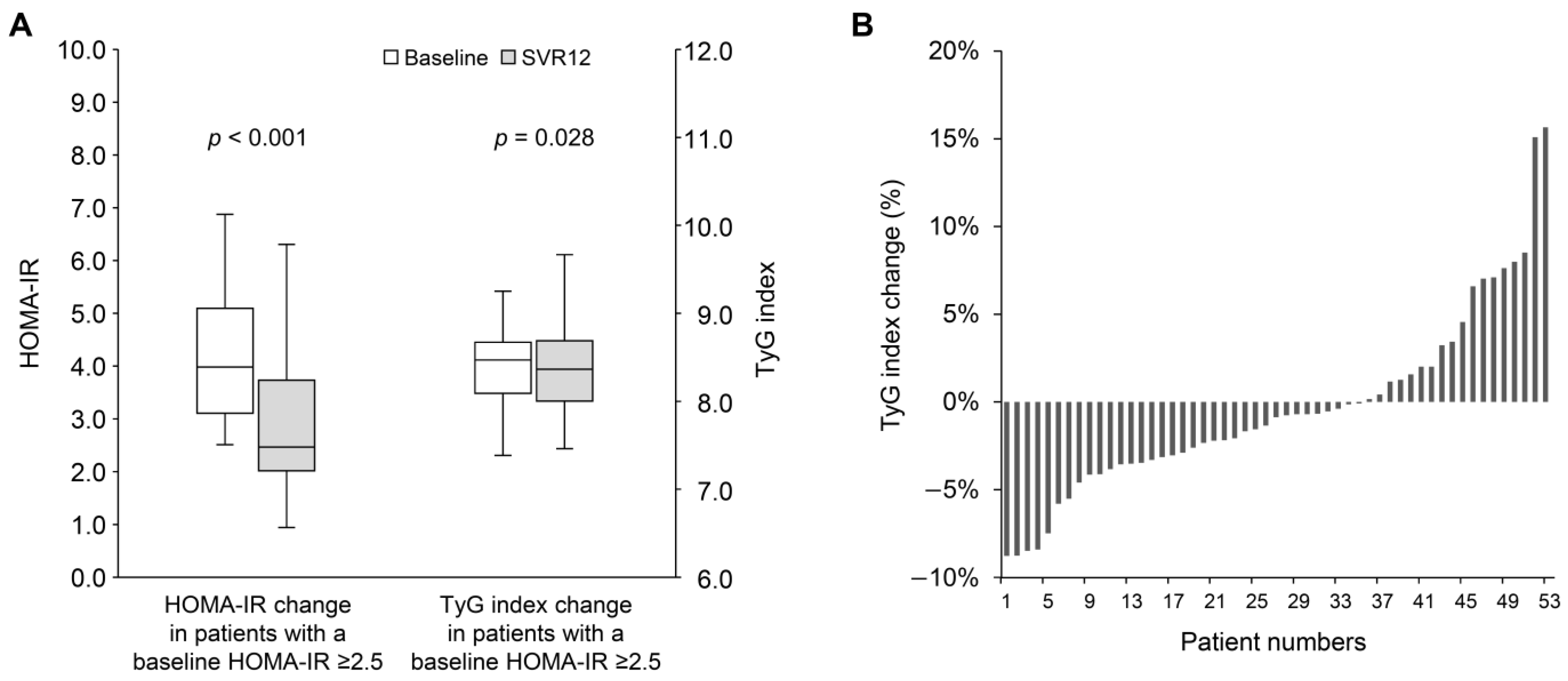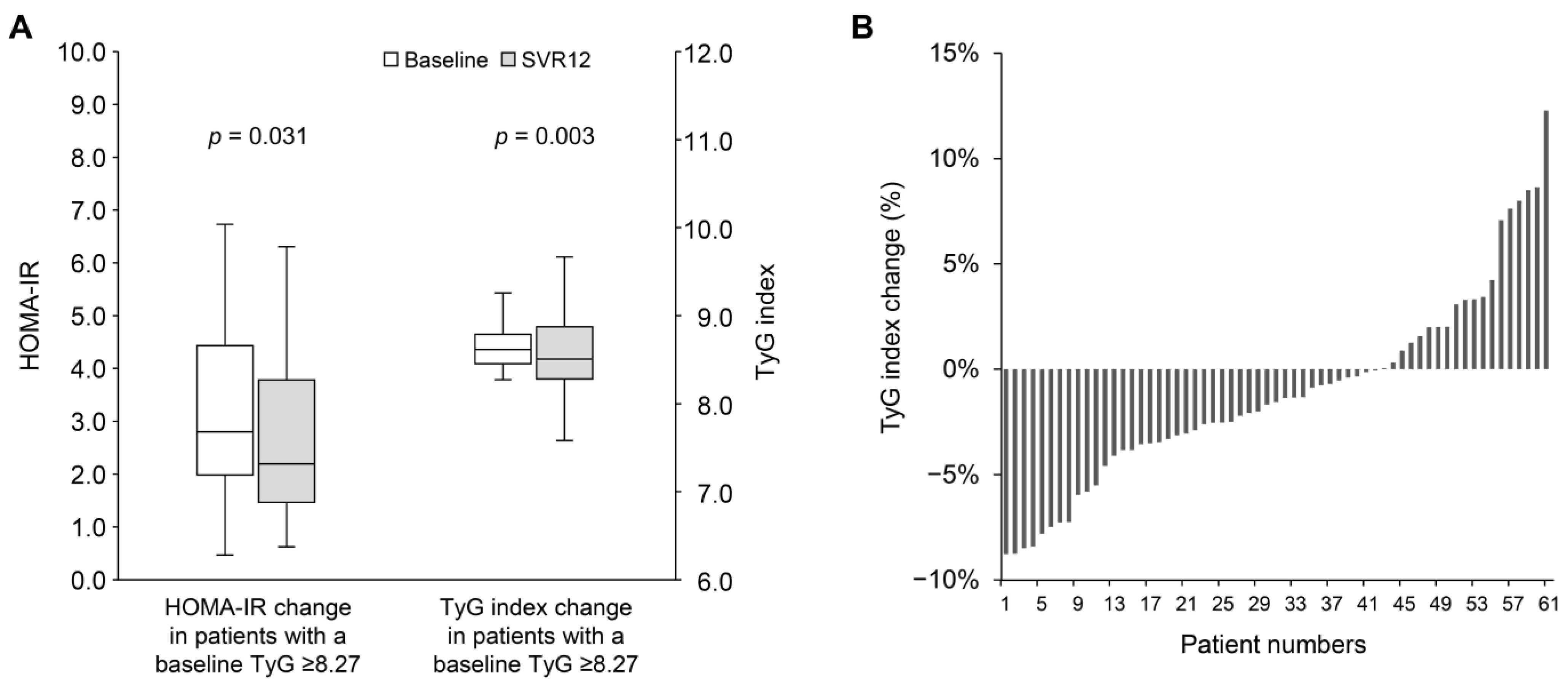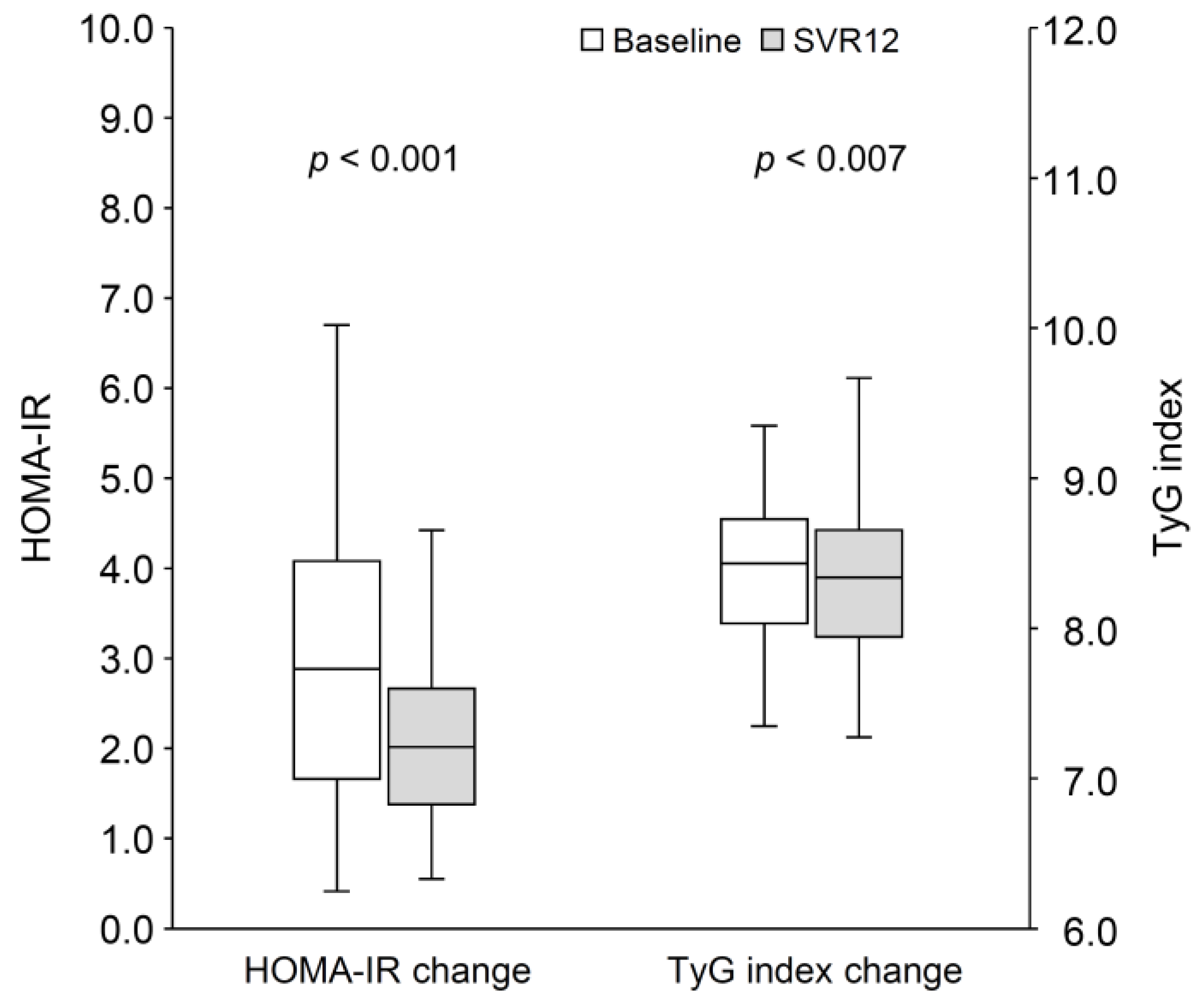The Triglyceride-Glucose Index as a Biomarker for Insulin Resistance Following Hepatitis C Virus Eradication: A Prospective Cohort Study
Abstract
1. Introduction
2. Patients and Methods
2.1. Study Design
2.2. Study Subjects
2.3. Main Outcome Measurements
2.4. Hepatic and Metabolic Parameter Measurements
2.5. Statistical Analyses
3. Results
3.1. Baseline Characteristics
3.2. The Correlations Between HOMA-IR and TyG Index
3.3. Metabolic Changes in Patients with Insulin Resistance
3.4. Metabolic Changes in Patients with a TyG Index ≥ 8.27
3.5. Metabolic Changes in Patients with Prediabetes
4. Discussion
Supplementary Materials
Author Contributions
Funding
Institutional Review Board Statement
Informed Consent Statement
Data Availability Statement
Acknowledgments
Conflicts of Interest
References
- World Health Organization. Global Health Sector Strategies on, Respectively, HIV, Viral Hepatitis and Sexually Transmitted Infections for the Period 2022–2030; World Health Organization: Geneva, Switzerland, 2022. [Google Scholar]
- Martinello, M.; Solomon, S.S.; Terrault, N.A.; Dore, G.J. Hepatitis C. Lancet 2023, 402, 1085–1096. [Google Scholar] [CrossRef] [PubMed]
- Leslie, J.; Geh, D.; Elsharkawy, A.M.; Mann, D.A.; Vacca, M. Metabolic dysfunction and cancer in HCV: Shared pathways and mutual interactions. J. Hepatol. 2022, 77, 219–236. [Google Scholar] [CrossRef] [PubMed]
- Cacoub, P.; Desbois, A.C.; Comarmond, C.; Saadoun, D. Impact of sustained virological response on the extrahepatic manifestations of chronic hepatitis C: A meta-analysis. Gut 2018, 67, 2025–2034. [Google Scholar] [CrossRef]
- Rossi, C.; Jeong, D.; Wong, S.; McKee, G.; Butt, Z.A.; Buxton, J.; Wong, J.; Darvishian, M.; Bartlett, S.; Samji, H.; et al. Sustained virological response from interferon-based hepatitis C regimens is associated with reduced risk of extrahepatic manifestations. J. Hepatol. 2019, 71, 1116–1125. [Google Scholar] [CrossRef]
- Russo, F.P.; Zanetto, A.; Gambato, M.; Bortoluzzi, I.; Al Zoairy, R.; Franceschet, E.; De Marchi, F.; Marzi, L.; Lynch, E.N.; Floreani, A.; et al. Hepatitis C virus eradication with direct-acting antiviral improves insulin resistance. J. Viral Hepat. 2020, 27, 188–194. [Google Scholar] [CrossRef]
- Cheng, P.N.; Sun, H.Y.; Feng, I.C.; Chiu, Y.C.; Wang, S.T.; Tan, D.C.; Chiu, H.C.; Chien, S.C.; Young, K.C. Interdependence of glycemic and lipid modulation in cured chronic hepatitis C patients by direct-acting antiviral agents. J. Microbiol. Immunol. Infect. 2023, 56, 20–30. [Google Scholar] [CrossRef] [PubMed]
- Alsebaey, A.; Elhelbawy, M.; Abdel-Razek, W.; Hashim, M.; Elshenawy, H.; Waked, I. HCV treatment with direct acting antivirals improves the insulin sensitivity. Expert Rev. Anti Infect. Ther. 2019, 17, 749–754. [Google Scholar] [CrossRef]
- Boraie, M.B.; Elnaggar, Y.A.; Ahmed, M.O.; Mahmoud, A.M. Effect of direct acting antiviral therapy of Chronic Hepatitis C virus on insulin resistance and Type2 DM in Egyptian patients (prospective study). Diabetes Metab. Syndr. 2019, 13, 2641–2646. [Google Scholar] [CrossRef]
- Graf, C.; Welzel, T.; Bogdanou, D.; Vermehren, J.; Beckel, A.; Bojunga, J.; Friedrich-Rust, M.; Dietz, J.; Kubesch, A.; Mondorf, A.; et al. Hepatitis C Clearance by Direct-Acting Antivirals Impacts Glucose and Lipid Homeostasis. J. Clin. Med. 2020, 9, 2702. [Google Scholar] [CrossRef]
- Hayashi, T.; Ogawa, E.; Furusyo, N.; Murata, M.; Hayashi, J. Influence of insulin resistance on the development of hepatocellular carcinoma after antiviral treatment for non-cirrhotic patients with chronic hepatitis C. Infect. Agents Cancer 2016, 11, 9. [Google Scholar] [CrossRef]
- Cersosimo, E.; Solis-Herrera, C.; Trautmann, M.E.; Malloy, J.; Triplitt, C.L. Assessment of pancreatic beta-cell function: Review of methods and clinical applications. Curr. Diabetes Rev. 2014, 10, 2–42. [Google Scholar] [CrossRef]
- DeFronzo, R.A.; Tobin, J.D.; Andres, R. Glucose clamp technique: A method for quantifying insulin secretion and resistance. Am. J. Physiol. 1979, 237, E214–E223. [Google Scholar] [CrossRef]
- Matthews, D.R.; Hosker, J.P.; Rudenski, A.S.; Naylor, B.A.; Treacher, D.F.; Turner, R.C. Homeostasis model assessment: Insulin resistance and beta-cell function from fasting plasma glucose and insulin concentrations in man. Diabetologia 1985, 28, 412–419. [Google Scholar] [CrossRef]
- Minh, H.V.; Tien, H.A.; Sinh, C.T.; Thang, D.C.; Chen, C.H.; Tay, J.C.; Siddique, S.; Wang, T.D.; Sogunuru, G.P.; Chia, Y.C.; et al. Assessment of preferred methods to measure insulin resistance in Asian patients with hypertension. J. Clin. Hypertens. 2021, 23, 529–537. [Google Scholar] [CrossRef]
- Guerrero-Romero, F.; Simental-Mendia, L.E.; Gonzalez-Ortiz, M.; Martinez-Abundis, E.; Ramos-Zavala, M.G.; Hernandez-Gonzalez, S.O.; Jacques-Camarena, O.; Rodriguez-Moran, M. The product of triglycerides and glucose, a simple measure of insulin sensitivity. Comparison with the euglycemic-hyperinsulinemic clamp. J. Clin. Endocrinol. Metab. 2010, 95, 3347–3351. [Google Scholar] [CrossRef]
- Sanchez-Garcia, A.; Rodriguez-Gutierrez, R.; Mancillas-Adame, L.; Gonzalez-Nava, V.; Diaz Gonzalez-Colmenero, A.; Solis, R.C.; Alvarez-Villalobos, N.A.; Gonzalez-Gonzalez, J.G. Diagnostic Accuracy of the Triglyceride and Glucose Index for Insulin Resistance: A Systematic Review. Int. J. Endocrinol. 2020, 2020, 4678526. [Google Scholar] [CrossRef]
- Yu, M.L.; Chen, P.J.; Dai, C.Y.; Hu, T.H.; Huang, C.F.; Huang, Y.H.; Hung, C.H.; Lin, C.Y.; Liu, C.H.; Liu, C.J.; et al. 2020 Taiwan consensus statement on the management of hepatitis C: Part (I) general population. J. Formos. Med. Assoc. 2020, 119, 1019–1040. [Google Scholar] [CrossRef]
- American Diabetes Association. Standards of medical care in diabetes—2014. Diabetes Care 2014, 37 (Suppl. 1), S14–S80. [Google Scholar] [CrossRef]
- Parcha, V.; Heindl, B.; Kalra, R.; Li, P.; Gower, B.; Arora, G.; Arora, P. Insulin Resistance and Cardiometabolic Risk Profile Among Nondiabetic American Young Adults: Insights From NHANES. J. Clin. Endocrinol. Metab. 2022, 107, e25–e37. [Google Scholar] [CrossRef]
- Lin, Z.H.; Xin, Y.N.; Dong, Q.J.; Wang, Q.; Jiang, X.J.; Zhan, S.H.; Sun, Y.; Xuan, S.Y. Performance of the aspartate aminotransferase-to-platelet ratio index for the staging of hepatitis C-related fibrosis: An updated meta-analysis. Hepatology 2011, 53, 726–736. [Google Scholar] [CrossRef]
- Vallet-Pichard, A.; Mallet, V.; Nalpas, B.; Verkarre, V.; Nalpas, A.; Dhalluin-Venier, V.; Fontaine, H.; Pol, S. FIB-4: An inexpensive and accurate marker of fibrosis in HCV infection. comparison with liver biopsy and fibrotest. Hepatology 2007, 46, 32–36. [Google Scholar] [CrossRef] [PubMed]
- Sterling, R.K.; Lissen, E.; Clumeck, N.; Sola, R.; Correa, M.C.; Montaner, J.; Sulkowski, M.S.; Torriani, F.J.; Dieterich, D.T.; Thomas, D.L.; et al. Development of a simple noninvasive index to predict significant fibrosis in patients with HIV/HCV coinfection. Hepatology 2006, 43, 1317–1325. [Google Scholar] [CrossRef] [PubMed]
- Chow, K.U.; Luxembourg, B.; Seifried, E.; Bonig, H. Spleen Size Is Significantly Influenced by Body Height and Sex: Establishment of Normal Values for Spleen Size at US with a Cohort of 1200 Healthy Individuals. Radiology 2016, 279, 306–313. [Google Scholar] [CrossRef]
- Saverymuttu, S.H.; Joseph, A.E.; Maxwell, J.D. Ultrasound scanning in the detection of hepatic fibrosis and steatosis. Br. Med. J. (Clin. Res. Ed.) 1986, 292, 13–15. [Google Scholar] [CrossRef] [PubMed]
- American Diabetes Association Professional Practice Committee. 2. Diagnosis and Classification of Diabetes: Standards of Care in Diabetes-2024. Diabetes Care 2024, 47, S20–S42. [Google Scholar] [CrossRef]
- Lopez-Jaramillo, P.; Gomez-Arbelaez, D.; Martinez-Bello, D.; Abat, M.E.M.; Alhabib, K.F.; Avezum, A.; Barbarash, O.; Chifamba, J.; Diaz, M.L.; Gulec, S.; et al. Association of the triglyceride glucose index as a measure of insulin resistance with mortality and cardiovascular disease in populations from five continents (PURE study): A prospective cohort study. Lancet Healthy Longev. 2023, 4, e23–e33. [Google Scholar] [CrossRef]
- Wang, J.; Yan, S.; Cui, Y.; Chen, F.; Piao, M.; Cui, W. The Diagnostic and Prognostic Value of the Triglyceride-Glucose Index in Metabolic Dysfunction-Associated Fatty Liver Disease (MAFLD): A Systematic Review and Meta-Analysis. Nutrients 2022, 14, 4969. [Google Scholar] [CrossRef]
- Liu, C.H.; Cheng, P.N.; Fang, Y.J.; Chen, C.Y.; Kao, W.Y.; Lin, C.L.; Yang, S.S.; Shih, Y.L.; Peng, C.Y.; Chang, Y.P.; et al. Risk of de novo HCC in patients with MASLD following direct-acting antiviral-induced cure of HCV infection. J. Hepatol. 2024, 82, 582–593. [Google Scholar] [CrossRef]
- Villani, R.; Di Cosimo, F.; Romano, A.D.; Sangineto, M.; Serviddio, G. Serum lipid profile in HCV patients treated with direct-acting antivirals: A systematic review and meta-analysis. Sci. Rep. 2021, 11, 13944. [Google Scholar] [CrossRef]
- Sasso, F.C.; Pafundi, P.C.; Caturano, A.; Galiero, R.; Vetrano, E.; Nevola, R.; Petta, S.; Fracanzani, A.L.; Coppola, C.; Di Marco, V.; et al. Impact of direct acting antivirals (DAAs) on cardiovascular events in HCV cohort with pre-diabetes. Nutr. Metab. Cardiovasc. Dis. 2021, 31, 2345–2353. [Google Scholar] [CrossRef]
- Liu, C.H.; Chang, Y.P.; Fang, Y.J.; Cheng, P.N.; Chen, C.Y.; Kao, W.Y.; Lin, C.L.; Yang, S.S.; Shih, Y.L.; Peng, C.Y.; et al. Dynamic change of metabolic dysfunction-associated steatotic liver disease in patients with hepatitis C virus infection after achieving sustained virologic response with direct-acting antivirals. J. Gastroenterol. 2024, 59, 609–620. [Google Scholar] [CrossRef]




| Variables | n = 111 | |
|---|---|---|
| Age, years | 61.0 | (55.0–73.0) |
| Male, n (%) | 51 | (45.9) |
| Hepatitis C virus RNA, log IU/mL | 5.8 | (5.2–6.5) |
| Aspartate aminotransferase, U/L | 39.0 | (26.0–70.0) |
| Alanine aminotransferase, U/L | 44.0 | (22.0–95.0) |
| APRI | 0.7 | (0.4–1.4) |
| FIB-4 index | 2.5 | (1.5–4.1) |
| <1.45, n (%) | 26 | (52.3) |
| 1.45 to 3.25, n (%) | 47 | (47.7) |
| >3.25, n (%) | 38 | (52.3) |
| Liver cirrhosis, n (%) | 20 | (18.0) |
| Direct-acting antivirals | ||
| sofosbuvir based, n (%) | 42 | (37.8) |
| glecaprevir + pibrentasvir, n (%) | 38 | (34.2) |
| elbasvir + grazoprevir, n (%) | 12 | (10.8) |
| ombitasvir/paritaprevir/ritonavir + dasabuvir, n (%) | 13 | (11.7) |
| daclatasvir + asunaprevir, n (%) | 6 | (5.4) |
| Coexisting hepatic steatosis, n (%) | 69 | (62.2) |
| Mild, n (%) | 43 | (38.7) |
| Moderate, n (%) | 19 | (17.1) |
| Severe, n (%) | 7 | (6.3) |
| Body mass index, kg/m2 | 23.1 | (21.1–26.3) |
| Total cholesterol, mg/dL | 161.0 | (144.0–185.0) |
| HDL cholesterol, mg/dL | 54.0 | (41.0–66.0) |
| LDL cholesterol, mg/dL | 93.0 | (78.0–109.0) |
| Triglyceride, mg/dL | 89.0 | (58.0–116.0) |
| HbA1c, % | 5.5 | (5.2–5.8) |
| Fasting plasma glucose, mg/dL | 96.0 | (90.0–104.0) |
| Fasting plasma insulin, μU/mL | 9.6 | (5.7–15.1) |
| Prediabetes, n (%) | 59 | (53.2) |
| HOMA-IR score | 2.4 | (1.4–3.9) |
| HOMA-IR score < 2.5, n (%) | 58 | (52.3) |
| HOMA-IR score ≥ 2.5, n (%) | 53 | (47.7) |
| TyG index | 8.36 | (7.99–8.64) |
| HOMA-IR < 2.5 n = 58 | HOMA-IR ≥ 2.5 n = 53 | |||||||||
|---|---|---|---|---|---|---|---|---|---|---|
| Baseline | SVR12 | p Value | Baseline | SVR12 | p Value | |||||
| AST, U/L | 41.5 | (27.0–70.0) | 22.5 | (18.8–30.0) | <0.001 | 38.0 | (25.5–71.5) | 27.0 | (20.5–38.0) | 0.001 |
| ALT, U/L | 49.0 | (20.8–87.0) | 16.5 | (13.0–22.3) | <0.001 | 43.0 | (22.5–105.5) | 21.0 | (15.0–29.5) | <0.001 |
| APRI | 0.65 | (0.39–1.34) | 0.31 | (0.23–0.68) | <0.001 | 0.68 | (0.45–1.59) | 0.41 | (0.32–1.14) | <0.001 |
| FIB-4 index | 2.37 | (1.50–3.63) | 1.89 | (1.21–3.47) | 0.149 | 2.64 | (1.46–4.30) | 2.63 | (1.6–5.04) | 0.583 |
| Total cholesterol, mg/dL | 161.0 | (148.3–185.0) | 177.5 | (160.5–208.0) | <0.001 | 158.0 | (140.0–184.5) | 179.0 | (153.0–203.0) | 0.004 |
| HDL cholesterol, mg/dL | 56.0 | (41.7–66.7) | 56.5 | (46.9–72.5) | 0.004 | 51.0 | (40.5–64.5) | 52.0 | (41.4–71.0) | 0.066 |
| LDL cholesterol, mg/dL | 96.0 | (79.0–111.5) | 109.0 | (92.8–128.3) | <0.001 | 92.0 | (75.5–108.5) | 112.0 | (90.5–123.5) | 0.006 |
| Triglyceride, mg/dL | 82.5 | (53.8–112.0) | 70.0 | (55.8–105.8) | 0.596 | 101.0 | (65.0–125.5) | 87.0 | (63.5–123.0) | 0.272 |
| HbA1c, % | 5.4 | (5.2–5.8) | 5.6 | (5.3–5.8) | 0.061 | 5.5 | (5.3–5.8) | 5.5 | (5.3–5.8) | 1.000 |
| Fasting plasma glucose, mg/dL | 94.5 | (86.8–99.0) | 96.0 | (91.0–101.5) | 0.001 | 100.0 | (96.0–109.0) | 100.0 | (90.0–109.0) | 0.028 |
| Fasting plasma insulin, μU/mL | 6.2 | (4.5–8.0) | 5.3 | (4.0–7.5) | 1.000 | 15.4 | (12.4–23.9) | 10.3 | (7.8–16.2) | <0.001 |
| HOMA-IR score | 1.4 | (1.0–2.0) | 1.3 | (0.9–2.0) | 0.896 | 4.0 | (3.1–5.4) | 2.5 | (2.0–3.9) | <0.001 |
| TyG index | 8.20 | (7.88–8.57) | 8.09 | (7.90–8.57) | 1.000 | 8.47 | (8.08–8.68) | 8.36 | (8.00–8.71) | 0.028 |
| TyG Index < 8.27 n = 49 | TyG Index ≥ 8.27 n = 62 | |||||||||
|---|---|---|---|---|---|---|---|---|---|---|
| Baseline | SVR12 | p Value | Baseline | SVR12 | p Value | |||||
| AST, U/L | 51.0 | (25.0–71.5) | 23.0 | (19.0–30.0) | <0.001 | 37.5 | (27.8–70.0) | 26.0 | (20.0–35.8) | <0.001 |
| ALT, U/L | 50.0 | (21.0–99.5) | 18.0 | (13.0–21.5) | <0.001 | 40.5 | (22.8–94.3) | 19.0 | (13.0–29.3) | <0.001 |
| APRI | 0.75 | (0.42–1.50) | 0.31 | (0.22–0.75) | <0.001 | 0.62 | (0.41–1.41) | 0.41 | (0.29–0.95) | <0.001 |
| FIB-4 index | 2.38 | (1.23–4.10) | 1.75 | (1.17–4.26) | 0.253 | 2.52 | (1.55–4.11) | 2.64 | (1.67–3.90) | 0.374 |
| Total cholesterol, mg/dL | 162.0 | (138.5–187.0) | 178.0 | (153.0–207.0) | <0.001 | 160.0 | (146.0–184.3) | 179.0 | (159.8–203.0) | <0.001 |
| HDL cholesterol, mg/dL | 59.0 | (46.5–70.0) | 61.0 | (52.0–77.8) | 0.061 | 47.4 | (35.8–63.0) | 50.5 | (39.8–68.5) | 0.005 |
| LDL cholesterol, mg/dL | 95.0 | (76.0–105.0) | 106.0 | (90.0–127.0) | 0.004 | 93.0 | (78.8–111.5) | 111.5 | (94.8–125.3) | <0.001 |
| Triglyceride, mg/dL | 55.0 | (47.0–69.0) | 62.0 | (52.5–74.0) | 0.061 | 112.0 | (100.3–137.8) | 99.5 | (70.8–139.5) | 0.001 |
| HbA1c, % | 5.5 | (5.4–5.7) | 5.5 | (5.3–5.8) | 0.440 | 5.5 | (5.2–5.9) | 5.6 | (5.3–5.8) | 0.272 |
| Fasting plasma glucose, mg/dL | 96.0 | (87.0–101.0) | 94.0 | (87.5–102.0) | 0.651 | 99.0 | (91.5–108.0) | 99.5 | (93.0–109.0) | 0.699 |
| Fasting plasma insulin, μU/mL | 6.8 | (4.5–14.3) | 6.5 | (4.0–8.8) | 0.041 | 11.3 | (8.2–16.4) | 9.1 | (6.1–15.9) | 0.010 |
| HOMA-IR score | 1.6 | (1.0–3.5) | 1.6 | (0.9–2.2) | 0.046 | 2.8 | (2.0–4.3) | 2.3 | (1.5–3.8) | 0.031 |
| TyG index | 7.95 | (7.69–8.12) | 7.97 | (7.79–8.24) | 0.312 | 8.62 | (8.46–8.83) | 8.52 | (8.27–8.89) | 0.003 |
| Patients Without Prediabetes n = 52 | Patients with Prediabetes n = 59 | |||||||||
|---|---|---|---|---|---|---|---|---|---|---|
| Baseline | SVR12 | p Value | Baseline | SVR12 | p Value | |||||
| AST, U/L | 43.0 | (27.0–69.3) | 23.5 | (19.3–32.8) | <0.001 | 38.0 | (26.0–73.0) | 24.0 | (20.0–31.0) | <0.001 |
| ALT, U/L | 49.5 | (24.0–97.5) | 19.0 | (13.0–28.5) | <0.001 | 40.0 | (21.0–95.0) | 17.0 | (13.0–23.0) | <0.001 |
| APRI | 0.67 | (0.42–1.39) | 0.36 | (0.24–0.94) | <0.001 | 0.66 | (0.41–1.49) | 0.39 | (0.26–0.81) | <0.001 |
| FIB-4 index | 2.41 | (1.34–4.02) | 2.27 | (1.19–4.24) | 0.278 | 2.63 | (1.56–4.26) | 2.27 | (1.44–4.07) | 0.127 |
| Total cholesterol, mg/dL | 160.5 | (141.0–183.3) | 178.0 | (162.5–203.0) | <0.001 | 163.0 | (146.0–189.0) | 180.0 | (154.0–206.0) | <0.001 |
| HDL cholesterol, mg/dL | 51.5 | (39.3–66.5) | 55.5 | (40.9–73.0) | 0.001 | 56.0 | (42.0–66.0) | 56.0 | (47.2–71.0) | 0.010 |
| LDL cholesterol, mg/dL | 91.5 | (79.0–105.8) | 110.5 | (93.0–124.5) | <0.001 | 94.0 | (78.0–111.0) | 109.0 | (91.0–127.0) | <0.001 |
| Triglyceride, mg/dL | 89.0 | (53.3–116.8) | 81.0 | (65.3–125.0) | 0.629 | 91.0 | (61.0–112.0) | 71.0 | (56.0–108.0) | 0.036 |
| HbA1c, % | 5.2 | (5.1–5.4) | 5.4 | (5.1–5.6) | 0.014 | 5.7 | (5.5–6.0) | 5.8 | (5.5–5.9) | 0.456 |
| Fasting plasma glucose, mg/dL | 92.0 | (86.0–96.0) | 92.0 | (86.0–98.0) | 0.189 | 103.0 | (96.0–111.0) | 103.0 | (94.0–110.0) | 0.448 |
| Fasting plasma insulin, μU/mL | 8.1 | (5.5–16.0) | 7.5 | (4.5–11.6) | 0.131 | 11.2 | (7.0–14.7) | 7.7 | (5.3–11.4) | <0.001 |
| HOMA-IR score | 1.8 | (1.2–3.5) | 1.8 | (1.0–2.8) | 0.216 | 2.9 | (1.7–4.1) | 2.0 | (1.4–2.7) | <0.001 |
| TyG index | 8.26 | (7.80–8.56) | 8.31 | (7.94–8.69) | 0.133 | 8.44 | (8.03–8.69) | 8.31 | (7.94–8.62) | 0.007 |
Disclaimer/Publisher’s Note: The statements, opinions and data contained in all publications are solely those of the individual author(s) and contributor(s) and not of MDPI and/or the editor(s). MDPI and/or the editor(s) disclaim responsibility for any injury to people or property resulting from any ideas, methods, instructions or products referred to in the content. |
© 2025 by the authors. Licensee MDPI, Basel, Switzerland. This article is an open access article distributed under the terms and conditions of the Creative Commons Attribution (CC BY) license (https://creativecommons.org/licenses/by/4.0/).
Share and Cite
Shen, S.-H.; Tsai, H.-J.; Li, Y.-H.; Chen, C.-C.; Lin, Y.-C.; Lee, S.-W.; Yang, S.-S.; Huang, Y.-H.; Lee, T.-Y. The Triglyceride-Glucose Index as a Biomarker for Insulin Resistance Following Hepatitis C Virus Eradication: A Prospective Cohort Study. J. Clin. Med. 2025, 14, 2963. https://doi.org/10.3390/jcm14092963
Shen S-H, Tsai H-J, Li Y-H, Chen C-C, Lin Y-C, Lee S-W, Yang S-S, Huang Y-H, Lee T-Y. The Triglyceride-Glucose Index as a Biomarker for Insulin Resistance Following Hepatitis C Virus Eradication: A Prospective Cohort Study. Journal of Clinical Medicine. 2025; 14(9):2963. https://doi.org/10.3390/jcm14092963
Chicago/Turabian StyleShen, Shih-Hsiung, Hsin-Ju Tsai, Yu-Hsuan Li, Chia-Chang Chen, Ying-Cheng Lin, Shou-Wu Lee, Sheng-Shun Yang, Yi-Hsiang Huang, and Teng-Yu Lee. 2025. "The Triglyceride-Glucose Index as a Biomarker for Insulin Resistance Following Hepatitis C Virus Eradication: A Prospective Cohort Study" Journal of Clinical Medicine 14, no. 9: 2963. https://doi.org/10.3390/jcm14092963
APA StyleShen, S.-H., Tsai, H.-J., Li, Y.-H., Chen, C.-C., Lin, Y.-C., Lee, S.-W., Yang, S.-S., Huang, Y.-H., & Lee, T.-Y. (2025). The Triglyceride-Glucose Index as a Biomarker for Insulin Resistance Following Hepatitis C Virus Eradication: A Prospective Cohort Study. Journal of Clinical Medicine, 14(9), 2963. https://doi.org/10.3390/jcm14092963







